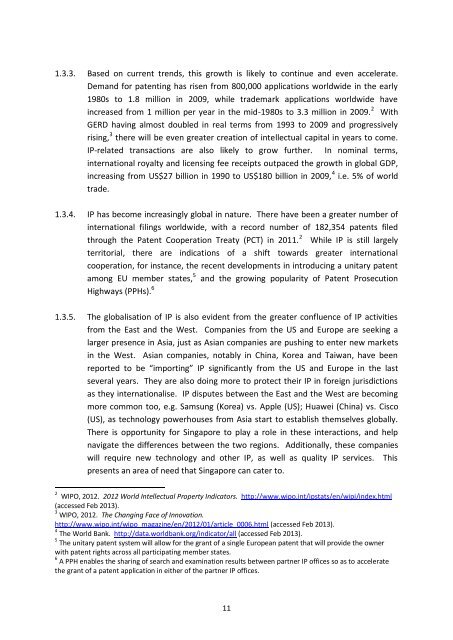(ip) hub master plan - Ministry of Law
(ip) hub master plan - Ministry of Law
(ip) hub master plan - Ministry of Law
Create successful ePaper yourself
Turn your PDF publications into a flip-book with our unique Google optimized e-Paper software.
1.3.3. Based on current trends, this growth is likely to continue and even accelerate.<br />
Demand for patenting has risen from 800,000 applications worldwide in the early<br />
1980s to 1.8 million in 2009, while trademark applications worldwide have<br />
increased from 1 million per year in the mid-1980s to 3.3 million in 2009. 2 With<br />
GERD having almost doubled in real terms from 1993 to 2009 and progressively<br />
rising, 3 there will be even greater creation <strong>of</strong> intellectual capital in years to come.<br />
IP-related transactions are also likely to grow further. In nominal terms,<br />
international royalty and licensing fee rece<strong>ip</strong>ts outpaced the growth in global GDP,<br />
increasing from US$27 billion in 1990 to US$180 billion in 2009, 4 i.e. 5% <strong>of</strong> world<br />
trade.<br />
1.3.4. IP has become increasingly global in nature. There have been a greater number <strong>of</strong><br />
international filings worldwide, with a record number <strong>of</strong> 182,354 patents filed<br />
through the Patent Cooperation Treaty (PCT) in 2011. 2 While IP is still largely<br />
territorial, there are indications <strong>of</strong> a shift towards greater international<br />
cooperation, for instance, the recent developments in introducing a unitary patent<br />
among EU member states, 5 and the growing popularity <strong>of</strong> Patent Prosecution<br />
Highways (PPHs). 6<br />
1.3.5. The globalisation <strong>of</strong> IP is also evident from the greater confluence <strong>of</strong> IP activities<br />
from the East and the West. Companies from the US and Europe are seeking a<br />
larger presence in Asia, just as Asian companies are pushing to enter new markets<br />
in the West. Asian companies, notably in China, Korea and Taiwan, have been<br />
reported to be “importing” IP significantly from the US and Europe in the last<br />
several years. They are also doing more to protect their IP in foreign jurisdictions<br />
as they internationalise. IP disputes between the East and the West are becoming<br />
more common too, e.g. Samsung (Korea) vs. Apple (US); Huawei (China) vs. Cisco<br />
(US), as technology powerhouses from Asia start to establish themselves globally.<br />
There is opportunity for Singapore to play a role in these interactions, and help<br />
navigate the differences between the two regions. Additionally, these companies<br />
will require new technology and other IP, as well as quality IP services. This<br />
presents an area <strong>of</strong> need that Singapore can cater to.<br />
2<br />
WIPO, 2012. 2012 World Intellectual Property Indicators. http://www.w<strong>ip</strong>o.int/<strong>ip</strong>stats/en/w<strong>ip</strong>i/index.html<br />
(accessed Feb 2013).<br />
3<br />
WIPO, 2012. The Changing Face <strong>of</strong> Innovation.<br />
http://www.w<strong>ip</strong>o.int/w<strong>ip</strong>o_magazine/en/2012/01/article_0006.html (accessed Feb 2013).<br />
4<br />
The World Bank. http://data.worldbank.org/indicator/all (accessed Feb 2013).<br />
5<br />
The unitary patent system will allow for the grant <strong>of</strong> a single European patent that will provide the owner<br />
with patent rights across all partic<strong>ip</strong>ating member states.<br />
6<br />
A PPH enables the sharing <strong>of</strong> search and examination results between partner IP <strong>of</strong>fices so as to accelerate<br />
the grant <strong>of</strong> a patent application in either <strong>of</strong> the partner IP <strong>of</strong>fices.<br />
11


